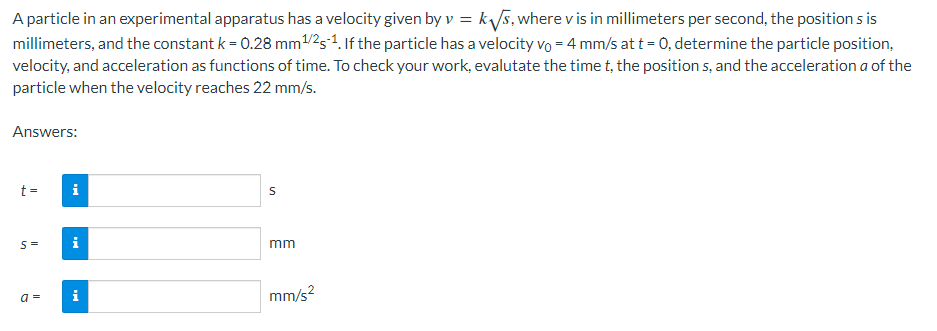A particle in an experimental apparatus has a velocity given by v = k√√/s, where v is in millimeters per second, the positions is millimeters, and the constant k = 0.28 mm ¹/25-¹1. If the particle has a velocity vo = 4 mm/s at t = 0, determine the particle position, velocity, and acceleration as functions of time. To check your work, evalutate the time t, the positions, and the acceleration a of the particle when the velocity reaches 22 mm/s. Answers: t= S= a= i i i S mm mm/s²
A particle in an experimental apparatus has a velocity given by v = k√√/s, where v is in millimeters per second, the positions is millimeters, and the constant k = 0.28 mm ¹/25-¹1. If the particle has a velocity vo = 4 mm/s at t = 0, determine the particle position, velocity, and acceleration as functions of time. To check your work, evalutate the time t, the positions, and the acceleration a of the particle when the velocity reaches 22 mm/s. Answers: t= S= a= i i i S mm mm/s²
Elements Of Electromagnetics
7th Edition
ISBN:9780190698614
Author:Sadiku, Matthew N. O.
Publisher:Sadiku, Matthew N. O.
ChapterMA: Math Assessment
Section: Chapter Questions
Problem 1.1MA
Related questions
Question
Dynamics of Rigid Bodies
Please help ASAP. Rate will be given accordingly. Please write your answer on paper. Thank you so much.
Note: The number of significant digits is set to 3. The tolerance is ±1 in the third significant digit.
I need Answer after 40 minutes.

Transcribed Image Text:A particle in an experimental apparatus has a velocity given by v = k₁√√s, where v is in millimeters per second, the position s is
millimeters, and the constant k = 0.28 mm ¹/25-¹. If the particle has a velocity vo = 4 mm/s at t = 0, determine the particle position,
velocity, and acceleration as functions of time. To check your work, evalutate the time t, the positions, and the acceleration a of the
particle when the velocity reaches 22 mm/s.
Answers:
t =
S=
a =
i
i
i
S
mm
mm/s²
Expert Solution
This question has been solved!
Explore an expertly crafted, step-by-step solution for a thorough understanding of key concepts.
Step by step
Solved in 3 steps with 3 images

Knowledge Booster
Learn more about
Need a deep-dive on the concept behind this application? Look no further. Learn more about this topic, mechanical-engineering and related others by exploring similar questions and additional content below.Recommended textbooks for you

Elements Of Electromagnetics
Mechanical Engineering
ISBN:
9780190698614
Author:
Sadiku, Matthew N. O.
Publisher:
Oxford University Press

Mechanics of Materials (10th Edition)
Mechanical Engineering
ISBN:
9780134319650
Author:
Russell C. Hibbeler
Publisher:
PEARSON

Thermodynamics: An Engineering Approach
Mechanical Engineering
ISBN:
9781259822674
Author:
Yunus A. Cengel Dr., Michael A. Boles
Publisher:
McGraw-Hill Education

Elements Of Electromagnetics
Mechanical Engineering
ISBN:
9780190698614
Author:
Sadiku, Matthew N. O.
Publisher:
Oxford University Press

Mechanics of Materials (10th Edition)
Mechanical Engineering
ISBN:
9780134319650
Author:
Russell C. Hibbeler
Publisher:
PEARSON

Thermodynamics: An Engineering Approach
Mechanical Engineering
ISBN:
9781259822674
Author:
Yunus A. Cengel Dr., Michael A. Boles
Publisher:
McGraw-Hill Education

Control Systems Engineering
Mechanical Engineering
ISBN:
9781118170519
Author:
Norman S. Nise
Publisher:
WILEY

Mechanics of Materials (MindTap Course List)
Mechanical Engineering
ISBN:
9781337093347
Author:
Barry J. Goodno, James M. Gere
Publisher:
Cengage Learning

Engineering Mechanics: Statics
Mechanical Engineering
ISBN:
9781118807330
Author:
James L. Meriam, L. G. Kraige, J. N. Bolton
Publisher:
WILEY